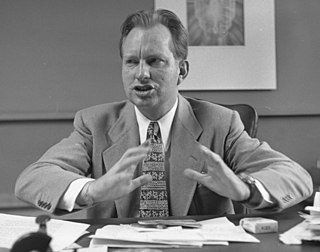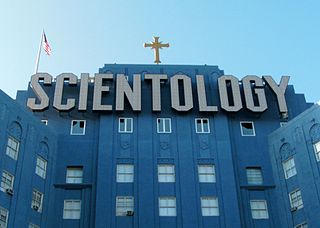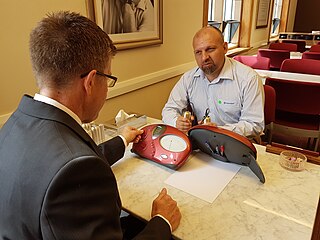
Lafayette Ronald Hubbard was an American author and the founder of Scientology. A prolific writer of pulp science fiction and fantasy novels in his early career, in 1950 he authored Dianetics: The Modern Science of Mental Health and established organizations to promote and practice Dianetics techniques. Hubbard created Scientology in 1952 after losing the intellectual rights to his literature on Dianetics in bankruptcy. He would lead the Church of Scientology, variously described as a cult, a new religious movement, or a business, until his death in 1986.

Xenu, also called Xemu, is a figure in the Church of Scientology's secret "Advanced Technology", a sacred and esoteric teaching. According to the "Technology", Xenu was the extraterrestrial ruler of a "Galactic Confederacy" who brought billions of his people to Earth in DC-8-like spacecraft 75 million years ago, stacked them around volcanoes, and killed them with hydrogen bombs. Official Scientology scriptures hold that the thetans of these aliens adhere to humans, causing spiritual harm.

The Free Zone, Freezone, or more recently identified as Independent Scientology, comprises a variety of non-affiliated independent groups, organizations, and individuals who practice Scientology beliefs and techniques independently of the Church of Scientology (CoS). Such practitioners range from those who closely adhere to the original teachings of Scientology's founder, L. Ron Hubbard, to those who have adapted their practices far from CoS beliefs and practices.

The Church of Scientology maintains a wide variety of beliefs and practices. The core belief holds that a human is an immortal, spiritual being (thetan) that is resident in a physical body. The thetan has had innumerable past lives, some of which, preceding the thetan's arrival on Earth, were lived in extraterrestrial cultures. Based on case studies at advanced levels, it is predicted that any Scientologist undergoing auditing will eventually come across and recount a common series of past-life events.

In Scientology, the concept of the thetan is similar to the concept of self, or the spirit or soul as found in several belief systems. The term is derived from the Greek letter Θ, theta, which in Scientology beliefs represents "the source of life, or life itself." In Scientology it is believed that it is the thetan, not the central nervous system, which commands the body.
Revolt in the Stars is a science fiction film screenplay written by Scientology founder L. Ron Hubbard in 1977. It tells the space opera story of how an evil galactic dictator, named Xenu, massacres many of his subjects by transporting them to Earth and killing them with atomic bombs. L. Ron Hubbard had already presented this story to his followers, as a true account of events that happened 75 million years ago, in a secret level of Scientology scripture called Operating Thetan, Level III. The screenplay was promoted around Hollywood circles in 1979, but attempts at fundraising and obtaining financing fell through, and the film was never made. Unofficial copies circulate on the Internet.

In Scientology, Operating Thetan (OT) is a state of complete spiritual freedom in which one is a "willing and knowing cause over life, thought, matter, energy, space and time". The Church of Scientology offers eight "levels" of OT, each level costing thousands of US dollars. The OT levels are confidential and not revealed to Scientologists until they reach the third Operating Thetan level. In practice, the objective of these levels is to remove "body thetans" which are "confused, disembodied souls from other planets who have attached themselves to us".

Auditing, also known as processing, is the core practice of Scientology. Scientologists believe that the role of auditing is to improve a person's abilities and to reduce or eliminate their neuroses. The Scientologist is asked questions about past events while holding two tin cans attached to an electrical resistance meter (galvanometer) with a dial. The term "auditing" was coined by L. Ron Hubbard in his 1950 book Dianetics: The Modern Science of Mental Health which describes the process. Auditing uses techniques from hypnosis that are intended to create dependency and obedience in the subject.

Dianetics: The Modern Science of Mental Health, sometimes abbreviated as DMSMH, is a book by L. Ron Hubbard about Dianetics, a pseudoscientific system that he claimed to have developed from a combination of personal experience, basic principles of Eastern philosophy and the work of Sigmund Freud. The book is considered part of Scientology's canon. It is colloquially referred to by Scientologists as Book One. The book launched the movement, which later defined itself as a religion, in 1950. As of 2013, New Era Publications, the international publishing company of Hubbard's works, sells the book in English and in 50 other languages.

Scientology founder L. Ron Hubbard explicitly compared his teachings to the science-fiction subgenre space opera. In his writings, wherein thetans were reincarnated periodically over quadrillions of years, retaining memories of prior lives, to which Hubbard attributed complex narratives about life throughout the universe. The most controversial of these myths is the story of Xenu, to whom Hubbard attributed responsibility for many of the world's problems.
In Dianetics and Scientology, Clear is a status afforded to followers by the Scientology organization, or by other Scientologists, after they complete certain activities. It is one of the major ostensible "states" practitioners strive to reach on their way up what the Scientologists call the Bridge to Total Freedom. Scientology followers are given the status of Clear when a person is deemed to be free of the influence of engrams – supposed unwanted emotions or painful traumas which Scientology claims are not readily available to the conscious mind. Scientologists believe that human beings accumulate anxieties, psychosomatic illnesses, and aberration due to receiving engrams throughout their current or past lives, and that by applying Dianetics, every single person can obtain the status of Clear.

An engram, as used in Dianetics and Scientology, is a detailed mental image or memory of a traumatic event from the past that occurred when an individual was partially or fully unconscious. It is considered to be pseudoscientific and is different from the meaning of "engram" in cognitive psychology. According to Dianetics and Scientology, from conception onwards, whenever something painful happens while the "analytic mind" is unconscious, engrams are supposedly being recorded and stored in an area of the mind Scientology calls the "reactive mind".

Scientology: A History of Man is a book by L. Ron Hubbard, first published in 1952 under the title What to Audit by the Scientific Press of Phoenix. According to the author, it provides "a coldblooded and factual account of your last sixty trillion years." It has gone through many editions since its first publication and is a key text of the Church of Scientology. The book has been ridiculed by critics of Scientology for its unusual writing style and pseudoscientific claims; it has been described as "a slim pretense at scientific method ... blended with a strange amalgam of psychotherapy, mysticism and pure science fiction; mainly the latter."

OT VIII or OT 8 is the highest current auditing level in Scientology. OT VIII is known as "The Truth Revealed" and was first released to select high-ranking public Scientologists in 1988, two years after the death of Scientology's founder, L. Ron Hubbard. OT VIII is only delivered to members of the Church of Scientology in one place—aboard the organization's private cruise ship, the Freewinds, and is additionally available from independent Scientology groups. There are a few advanced auditors that are able to deliver the level to those who meet the prerequisites.

This bibliography of Scientology includes Scientology and Dianetics-related books authored by L. Ron Hubbard and those produced by the Church of Scientology and its related organizations. Books compiled by the Church of Scientology and published after the death of Hubbard are usually indicated as "Based on the Works of L. Ron Hubbard". Books bearing L. Ron Hubbard's name are considered texts of Scientology's canon.
The amount of material on Dianetics and Scientology is extensive, to say the least. This material is composed of books by L. Ron Hubbard ; compilations of his works; taped lectures; auditor training materials ; course packages; booklets; a large number of magazines and annuals; and video recordings of the major annual events.

The Bridge to Total Freedom, also known as the Classification, Gradation and Awareness Chart, is Scientology's primary action plan and road map to guide a person through the sequential steps to attain Scientology's concept of spiritual freedom. Displayed in every Scientology organization as an enormous poster using red ink, the comprehensive chart contains almost every service available within Scientology. All steps on the Bridge cost money.
According to the beliefs of the Church of Scientology, the Marcab Confederacy is said to be one of the most powerful galactic civilizations still active. Church founder L. Ron Hubbard describes it as:
Various planets united into a very vast civilization which has come forward up through the last 200,000 years, formed out of the fragments of earlier civilizations. In the last 10,000 years they have gone on with a sort of decadent kicked-in-the-head civilization that contains automobiles, business suits, fedora hats, telephones, spaceships — a civilization which looks almost an exact duplicate but is worse off than the current US civilization.

Scientology is a set of beliefs and practices invented by the American author L. Ron Hubbard, and an associated movement. It is variously defined as a cult, a business, a religion, a scam, or a new religious movement. Hubbard initially developed a set of ideas that he called Dianetics, which he represented as a form of therapy. An organization that he established in 1950 to promote it went bankrupt, and Hubbard lost the rights to his book Dianetics in 1952. He then recharacterized his ideas as a religion, likely for tax purposes, and renamed them Scientology. By 1954, he had regained the rights to Dianetics and founded the Church of Scientology, which remains the largest organization promoting Scientology. There are practitioners independent of the Church, in what is referred to as the Free Zone. Estimates put the number of Scientologists at under 40,000 worldwide.

Scientology is in part derived from, and shares elements with, a number of esoteric or occult systems. The extent of the influence of specific occult belief systems on Scientology is a subject of debate amongst scholars.






